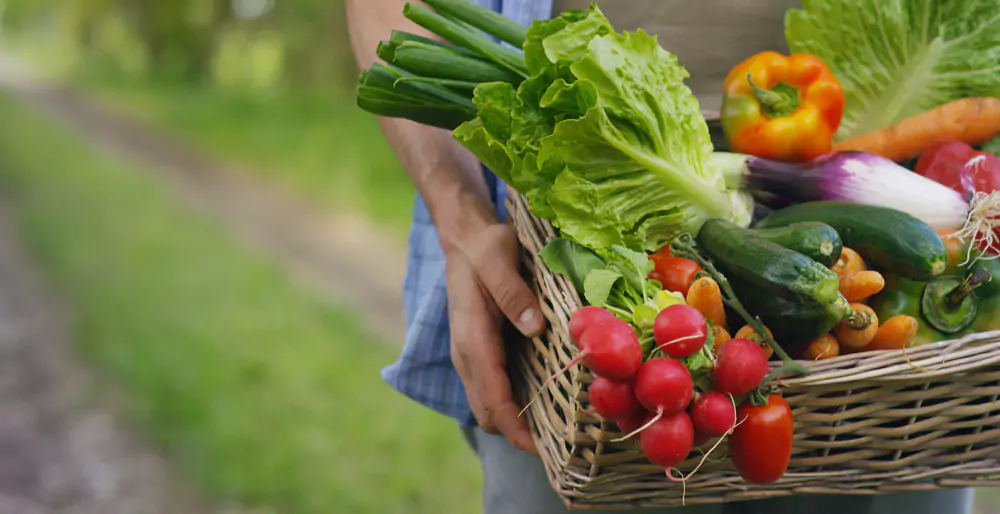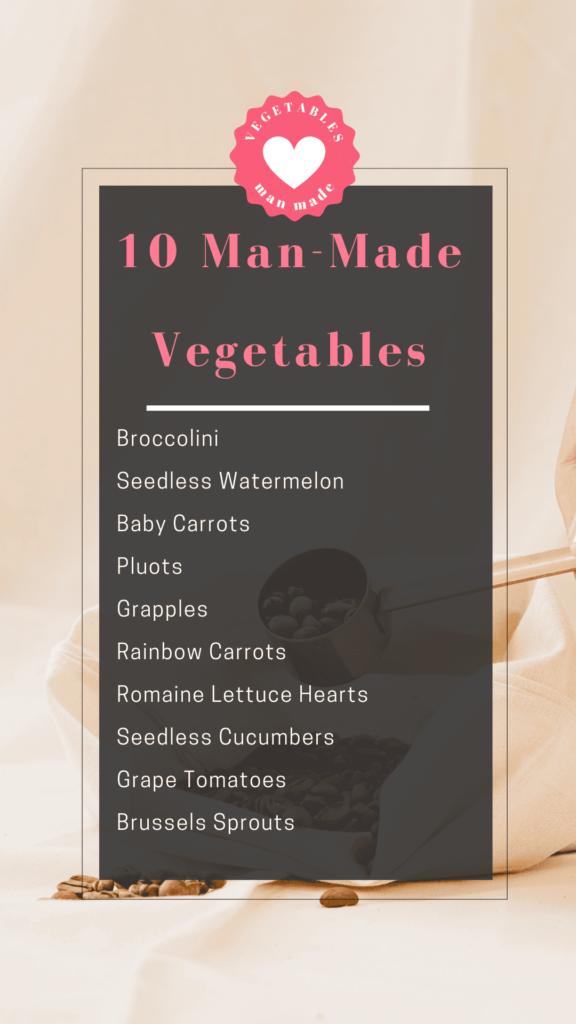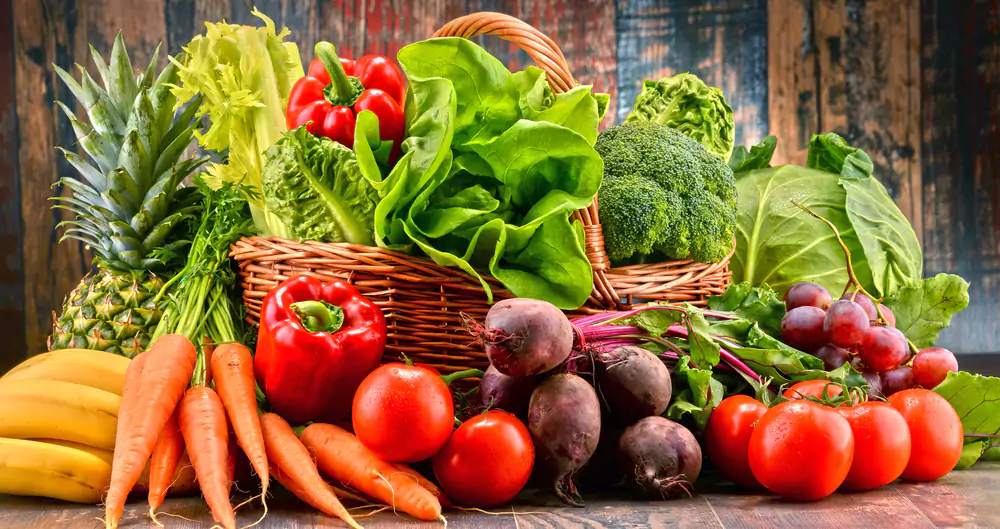Have you ever wondered about the origins of the vegetables we consume daily or what Vegetables are Man-Made? While humans have cultivated some vegetables for thousands of years, others have been specifically bred and modified through selective breeding techniques to enhance their taste, appearance, and nutritional value.
In this blog post, we will delve into the fascinating world of man-made vegetables, exploring their creation process and highlighting some notable examples. So, let’s embark on a journey to uncover man-made veggies and how they have become an integral part of our diets.
Recommended: What Vegetables Should Not Be Juiced
Difference Between Man-Made And GMO Vegetables
Man-made vegetables refer to those that are created through selective breeding and hybridization techniques by humans without any genetic modification. These vegetables are developed by crossing different varieties of plants to enhance desirable traits such as taste, size, color, or disease resistance.
On the other hand, GMO (Genetically Modified Organism) vegetables are produced by introducing specific genes from one organism into another using biotechnology techniques. This genetic modification allows for incorporating desired traits that may not naturally occur in the plant, such as herbicide resistance or increased nutritional content.
While both man-made and GMO vegetables involve human intervention in their development, the key distinction lies in the method used to introduce new traits – selective breeding for man-made vegetables and genetic modification for GMO vegetables.
How Are Man-Made Vegetables Created?

Man-made vegetables, also known as genetically modified organisms (GMOs), are created through genetic engineering. This involves manipulating the DNA of plants to introduce specific traits or characteristics. Scientists identify desirable genes from one organism and transfer them into the DNA of another plant species. This can be done using various techniques, such as gene splicing, where specific genes are cut and inserted into the target plant’s genome.
The modified plant then undergoes rigorous testing to ensure its safety and efficacy before being commercially used. The goal of creating man-made vegetables is to enhance their nutritional value, increase resistance to pests and diseases, improve yield, and address other agricultural challenges.
Purpose Of Creating Man-Made Vegetables
The purpose of creating man-made vegetables is to provide consumers with a sustainable and nutritious food source. By using advanced agricultural technologies, such as hydroponics and vertical farming, scientists and researchers can grow vegetables that are tasty and fresh, have a longer shelf life, and require less water and land to cultivate.
Additionally, man-made vegetables can be engineered to have higher nutritional values, such as increased vitamin and mineral content, or specific health benefits, such as reducing inflammation or improving heart health.
Benefits Of Man-Made Vegetables

Man-made vegetables, known as cultured or lab-grown vegetables, offer several benefits over traditionally grown vegetables. Here are some of the key advantages:
- Man-made vegetables are grown in controlled environments, which reduces the risk of contamination and increases food safety.
- Man-made vegetables can be engineered to have higher levels of nutrients, such as vitamins and minerals, than traditionally grown vegetables.
- Man-made vegetables require significantly less water than usually-grown vegetables, which can help conserve water resources.
- Man-made vegetables can be grown in vertically stacked layers, increasing crop yields by up to 30% compared to traditional farming methods.
- Man-made vegetables can be grown in small, controlled environments, reducing the land needed for farming.
- Man-made vegetables can have an extended shelf life compared to traditionally grown vegetables, which can reduce food waste and improve food security.
Top 10 Man-Made Vegetables
Here are 10 examples of man-made vegetables:

1- Broccolini
Broccolini is a cross between broccoli and Chinese kale (gai lan). It has long, slender stems with small florets and a milder flavor than traditional broccoli.
2- Seedless Watermelon
Seedless watermelons are created by crossing watermelon varieties with different ploidy levels. The resulting fruit contains tiny, edible, or nearly seedless seeds.
3- Baby Carrots
Baby carrots are not young carrots but regular-sized ones that have been cut and shaped into smaller, bite-sized pieces. They are convenient for snacking and cooking.
4- Pluots
Pluots are a hybrid fruit resulting from the crossbreeding of plums and apricots. They have smooth skin like plums but inherit the sweetness and juiciness of apricots.
5- Grapples
Grapples are apples infused with grape flavor using a patented process. This gives them a unique taste similar to grapes while retaining the texture and appearance of apples.
6- Rainbow Carrots
Rainbow carrots mix different colored carrot varieties, including orange, purple, yellow, and white. They add visual appeal to dishes and offer a range of flavors.
7- Romaine Lettuce Hearts
Romaine lettuce hearts are the inner leaves of romaine lettuce harvested when they are young and tender. They have a sweeter taste compared to mature romaine lettuce.
8- Seedless Cucumbers
Seedless cucumbers are produced by cross-pollinating cucumber plants with a specific genetic trait that prevents the formation of mature seeds. This results in cucumbers with fewer or no seeds.
9- Grape Tomatoes
Grape tomatoes are small, oblong-shaped tomatoes that resemble grapes in size and appearance. They have a sweeter flavor and are often used in salads and as a snack.
10- Brussels Sprouts
Brussels sprouts are a man-made vegetable that originated from wild cabbage. Through selective breeding, the sprouts were developed to grow larger and have a milder taste compared to their wild counterparts.
Can Man-Made Vegetables Be Genetically Modified?
Yes, man-made vegetables can be genetically modified. Genetic modification involves altering an organism’s genetic material, including plants, to introduce desired traits or characteristics. Through genetic engineering techniques, scientists can manipulate the DNA of vegetables to enhance their nutritional content, improve resistance to pests and diseases, increase yield, and extend shelf life.
This can be done by introducing other organisms’ genes or modifying existing genes within the vegetable’s genome. Genetically modified vegetables have been developed and cultivated worldwide, contributing to agriculture and food production advancements.
Potential Risks Associated With Consuming Man-Made Vegetables
Here are some of the risks associated with man-made veggies you need to know:
- Man-made vegetables may not provide a balanced mix of nutrients, leading to nutrient deficiencies or excesses.
- Some man-made vegetables may contain proteins or other substances that can cause allergic reactions in specific individuals.
- Some man-made vegetables may contain harmful chemicals or heavy metals that can be toxic to human health.
- The production and regulation of man-made vegetables is still a relatively new and evolving field, and there may be a lack of standardization and oversight regarding safety and quality.
Are Man-Made Vegetables Good For You – Verdict
No, man-made vegetables are not suitable for you. While they may appear similar to natural vegetables, man-made vegetables are typically genetically modified organisms (GMOs) that have been altered in a laboratory to enhance certain traits. These modifications often involve the insertion of foreign genes or the use of pesticides and herbicides. Consuming GMOs has been linked to various health concerns, including allergic reactions, organ damage, and an increased risk of developing chronic diseases.
Additionally, man-made vegetables may lack essential nutrients and antioxidants found in natural vegetables. It is recommended to prioritize consuming organic, non-GMO, and naturally grown vegetables for optimal health benefits.
FAQs
What Vegetable Was Man Made?
There is no specific vegetable that can be classified as “man-made.” Vegetables have evolved naturally through selective breeding and cultivation by humans, but they are not artificially created or genetically engineered.
Are Some Vegetables Man Made?
Yes, humans have selectively bred and cultivated some vegetables over centuries to enhance certain desirable traits. This domestication has resulted in various vegetable varieties that differ significantly from their wild ancestors.
Is Broccoli A Man Made Vegetable?
Yes, broccoli is considered a man-made vegetable. It results from selective breeding and cultivation techniques applied to wild cabbage plants, leading to a distinct vegetable with dense flower buds.
Are Kale And Broccoli Man Made?
Yes, both kale and broccoli are man-made vegetables. Kale is believed to have originated from wild cabbage plants that were selectively bred for their leaves, resulting in the development of the leafy green vegetable we know today.
Are Man-Made Vegetables Good For You?
Man-made vegetables, essentially domesticated varieties, can still provide numerous health benefits as they retain many essential nutrients in their wild counterparts.
Is Cauliflower Man Made?
Yes, cauliflower is considered a man-made vegetable. It is derived from wild cabbage plants through selective breeding techniques that emphasize the development of compact inflorescence (the edible part) with reduced leaf formation.
Are Carrots Man Made?
Carrots are not considered man-made vegetables. They are believed to have originated from wild carrot species and have been cultivated for thousands of years to develop various colors and flavors.

![Is Sugarcane A Fruit, Vegetable, Or Grass? [ Answered 2024 ] Is Sugarcane A Fruit](https://juicerhunter.com/wp-content/uploads/2023/10/Is-Sugarcane-A-Fruit-150x150.webp)
![What is Old World Pepperoni? - [ Know The Difference ] What is Old World Pepperoni](https://juicerhunter.com/wp-content/uploads/2023/09/What-is-Old-World-Pepperoni-150x150.jpg)
![Carbs in Lime Juice - [ Nutritional Value ] Carbs in Lime Juice](https://juicerhunter.com/wp-content/uploads/2023/10/Carbs-in-Lime-Juice-150x150.webp)

![Orange Watermelon Facts - [ Taste and Benifits ] Orange Watermelon](https://juicerhunter.com/wp-content/uploads/2023/11/Orange-Watermelon-150x150.webp)
